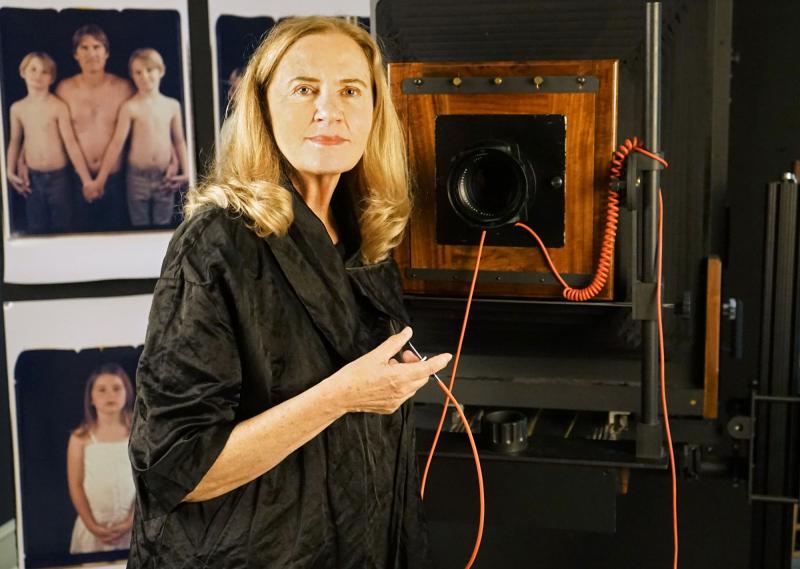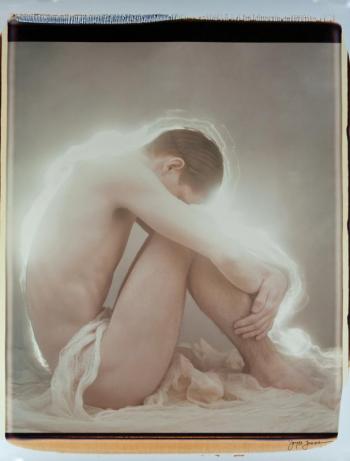Watch as Joyce Tenneson reaches right through the camera
ROCKLAND — In 1986, photographer Joyce Tenneson was just reaching a pinnacle of her career in New York City with more than 20 shows under her belt and several published books when the Poloroid corporation specifically sought her out to offer her a grant. Poloroid, known best for its instant film and cameras, wanted her to shoot subjects of her choice with their five-foot-tall, 235 pound camera.
“It was basically a refrigerator on wheels,” she said. “Two guys had to move it around. Once I shot the photo, they would get down on their knees and pull the print from the camera.”
The print would then have to be sliced off with a box cutter.
“Every time I used it, I had to give them one of my best images, which they kept for their collection,” she said.
Normally that camera would be $1,700 a day to rent with $200 for each exposure. If that wasn’t not enough pressure, the very nature of Poloroid photography has no negatives and no prints could be altered. To get the perfect shot, Tenneson was looking for a face that could transcend the camera.
“I found my subjects everywhere—on the subway, at the bank, at art openings or at coffee shops—people of varied shapes, skin colors, sizes and sizes and ages,” she said. One day riding the subway, she noticed a thin, frail girl with blond hair. “I saw her as an alter ego,” she said, “and I approached her, gave her my card and said I’d like to photograph her.” This young girl, Suzanne, would prominently appear in many more of Tenneson’s pictures over the next 30 years.
“I am an intimist and what thrills me is to connect with people,” explained Tenneson. “What I try to do when behind the camera is show something secret about them. I try to reveal their inner essence. But, to do that, you have to establish trust. And I think my passion is connecting with that transcendence the moment I take the shot.”
Now the work which she calls Grace: Unseen Poloroids 1986-2006 is hanging for the first time at the Dowling Walsh gallery in Rockland. For many years this collection lay in storage in New York City, never seen, never published.
“At the end of the day, you’re exhausted, you’ve been on your feet 10 hours,” she said. “Many of these photographs were of the same person, but just different shots. I had to make a quick editorial decision to keep one photo and the rest had to go into storage because there was no place to store them in the studio.”
Most of the models in Grace: Unseen Poloroids are wrapped with a simple white fabric, or partly unclothed. “I like my figures to be outside of time,” she said. And the props she uses are elemental as well, such as a curving snake skeleton that Suzanne holds behind her back. “When I found it and just liked the way it looked,” said Tenneson. “I didn’t even think about it until someone reminded me later that snakes are a symbol of transformation.”
There is a lush femininity throughout this series, a vulnerability with an undercurrent of inner radiance and power behind each person’s direct gaze. In another portrait called The Queen (one of Tenneson’s favorites), a nude heavyset woman lies on her side wearing a handmade paper crown made by Tenneson, as she stares evenly at the camera. And she is Suzanne’s opposite in almost every way: durable, earthy, and seasoned.
“I want to allow others to reveal and celebrate aspects of themselves that are usually hidden,” said Tenneson.
The other reason these 20” x 24” giant photographs are so special is because the hand-spooled film used for this particular camera is on its way to being extinct.
“It’s not that the camera has become defunct, it’s that when the Poloroid company went bankrupt, the existing film was bought by a private hedge fund investor,” explained Tenneson. “He put the remaining film in a rented refrigerated warehouse in New Jersey. The expiration of all of that film will be up in a year. It’s specially handmade but cannot be mass produced. They are trying to reproduce this same film with the Impossible Project in Amsterdam, but it’s just not the same. It looks different.”
Tonight, July 15, 2016, the Farnsworth Art Museum prepares to honor Tenneson with the 2016 Maine in America Award. The award is presented by the Farnsworth's Presidents Council to honor an individual or group who has made an outstanding contribution to Maine's role in American art. With more than 150 exhibitions worldwide and the author of 15 books, she is the recipient of numerous awards, including the International Center of Photography's Infinity Award, for best applied photography, and the 2012 Lifetime Achievement Award from the Professional Photographers of America.
The award presentation will occur during the Farnsworth Art Museum's 2016 Summer Gala on the grounds of the museum.
Grace: Unseen Poloroids hangs at Dowling Walsh until July 30. Many of these photographs will go to private collectors. And soon, this style of shooting film will be gone forever. Suzanne has aged. The Queen has aged. But the way Tenneson has been able to reach through the camera and pull out their inner essence, the secrets in those haunted stares will live on forever.
Kay Stephens can be reached at news@penbaypilot.com





































